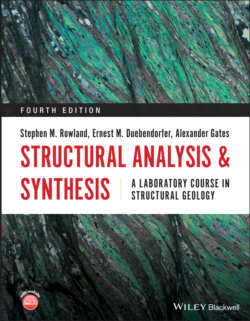Читать книгу Structural Analysis and Synthesis - Stephen M. Rowland - Страница 28
Drawing a Topographic Profile
ОглавлениеTopographic profiles are the first step in drawing a geologic cross section. The profiles show the relief at the earth's surface along the top of the geologic structure section. Usually you will have to construct your own topographic profile. Cross sections must be drawn on topographic profiles with no vertical exaggeration. The technique for drawing a topographic profile is as follows:
1 Draw the section line on the map (Figure 2.11a).
2 Lay the edge of a piece of paper along the section line, and mark and label on the paper each contour, stream, and ridge crest (Figure 2.11b).
3 Scale off and label the appropriate elevations on a piece of graph paper (Figure 2.11c). Graph paper with 10 or 20 squares per inch is ideal for 7.5‐minute quadrangle maps because the scale is 1 in = 2000 ft. Notice that the map scales on Figures 2.11a and 2.11b are the same as the vertical scale on Figures 2.11c and 2.11d. It is very important that the vertical and horizontal scales are the same on structure sections. This is a very common oversight. If the scale of the structure section is not the same as the scale of the map then the dips cannot be drawn at their normal angle.Figure 2.11 Technique for drawing a topographic profile. (a) Draw section line on map. (b) Transfer contour crossings, streams, and other features to another sheet of paper. (c) Transfer points to proper elevation on cross section sheet. (d) Connect points in a way that reflects the topographic subtleties recorded on the map.
4 Lay the labeled paper on the graph paper and transfer each contour, stream, and ridge crest point to the proper elevation on the graph paper (Figure 2.11c).
5 Connect the points (Figure 2.11d).
